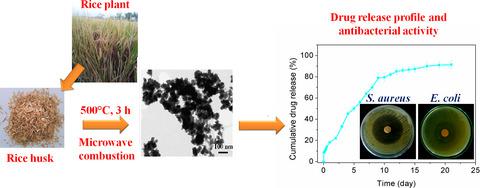当前位置:
X-MOL 学术
›
Int. J. Appl. Ceram. Technol.
›
论文详情
Our official English website, www.x-mol.net, welcomes your feedback! (Note: you will need to create a separate account there.)
Amorphous silica nanoparticles derived from biowaste via microwave combustion for drug delivery
International Journal of Applied Ceramic Technology ( IF 2.1 ) Pub Date : 2020-12-29 , DOI: 10.1111/ijac.13693 P. Araichimani 1, 2 , G. Suresh Kumar 3 , K.M. Prabu 1 , Gopalu Karunakaran 4 , N. Van Minh 5 , Evgeny Kolesnikov 6 , Mikhail V. Gorshenkov 7
International Journal of Applied Ceramic Technology ( IF 2.1 ) Pub Date : 2020-12-29 , DOI: 10.1111/ijac.13693 P. Araichimani 1, 2 , G. Suresh Kumar 3 , K.M. Prabu 1 , Gopalu Karunakaran 4 , N. Van Minh 5 , Evgeny Kolesnikov 6 , Mikhail V. Gorshenkov 7
Affiliation

|
Amorphous silica nanoparticles are a promising platform for constructing drug delivery vehicles owing to their high biocompatibility and favorable surface chemistry. In the current study, we report the preparation of amorphous silica nanoparticles using rice husk biowaste via easy and rapid microwave‐assisted combustion. The obtained results from various characterizations indicate that the prepared sample is an amorphous form of silica nanoparticles having sizes 50–80 nm with high purity. Ciprofloxacin was used as the model drug and it was released from silica nanocarrier in a controlled and prolonged manner. The ciprofloxacin release kinetics was investigated using the Higuchi model and Ritger‐Peppas model which corroborate that different process like desorption, diffusion, and surface erosion may be involved in the release of ciprofloxacin from the prepared silica nanocarrier. The antibacterial susceptibility test revealed that the ciprofloxacin loaded silica nanocarrier exhibit a bacterial inhibition zone about 32 ± 4 and 44 ± 3 mm against Escherichia coli and Staphylococcus aureus, respectively. This study can be useful to develop a versatile nanocarrier with controlled delivery of ciprofloxacin to treat different types of bacterial infections.
中文翻译:

通过微波燃烧从生物废物中衍生出来的无定形二氧化硅纳米粒子,用于药物输送
非晶态二氧化硅纳米粒子因其高生物相容性和良好的表面化学性质而成为构建药物递送载体的有前途的平台。在当前的研究中,我们报告了利用稻壳生物废料通过简单快速的微波辅助燃烧制备无定形二氧化硅纳米粒子的过程。从各种表征获得的结果表明,所制备的样品为无定形形式的二氧化硅纳米粒子,具有50-80 nm的尺寸,且纯度高。环丙沙星用作模型药物,并且以受控且长期的方式从二氧化硅纳米载体上释放。使用Higuchi模型和Ritger-Peppas模型研究了环丙沙星的释放动力学,证实了不同的过程,如解吸,扩散,环丙沙星从制备的二氧化硅纳米载体中的释放可能涉及表面腐蚀。抗菌药敏试验表明,载有环丙沙星的二氧化硅纳米载体对细菌的抑制作用范围约为32±4和44±3 mm。分别为大肠杆菌和金黄色葡萄球菌。这项研究对于开发可控制递送环丙沙星的多功能纳米载体可能有用,以治疗不同类型的细菌感染。
更新日期:2020-12-29
中文翻译:

通过微波燃烧从生物废物中衍生出来的无定形二氧化硅纳米粒子,用于药物输送
非晶态二氧化硅纳米粒子因其高生物相容性和良好的表面化学性质而成为构建药物递送载体的有前途的平台。在当前的研究中,我们报告了利用稻壳生物废料通过简单快速的微波辅助燃烧制备无定形二氧化硅纳米粒子的过程。从各种表征获得的结果表明,所制备的样品为无定形形式的二氧化硅纳米粒子,具有50-80 nm的尺寸,且纯度高。环丙沙星用作模型药物,并且以受控且长期的方式从二氧化硅纳米载体上释放。使用Higuchi模型和Ritger-Peppas模型研究了环丙沙星的释放动力学,证实了不同的过程,如解吸,扩散,环丙沙星从制备的二氧化硅纳米载体中的释放可能涉及表面腐蚀。抗菌药敏试验表明,载有环丙沙星的二氧化硅纳米载体对细菌的抑制作用范围约为32±4和44±3 mm。分别为大肠杆菌和金黄色葡萄球菌。这项研究对于开发可控制递送环丙沙星的多功能纳米载体可能有用,以治疗不同类型的细菌感染。



























 京公网安备 11010802027423号
京公网安备 11010802027423号